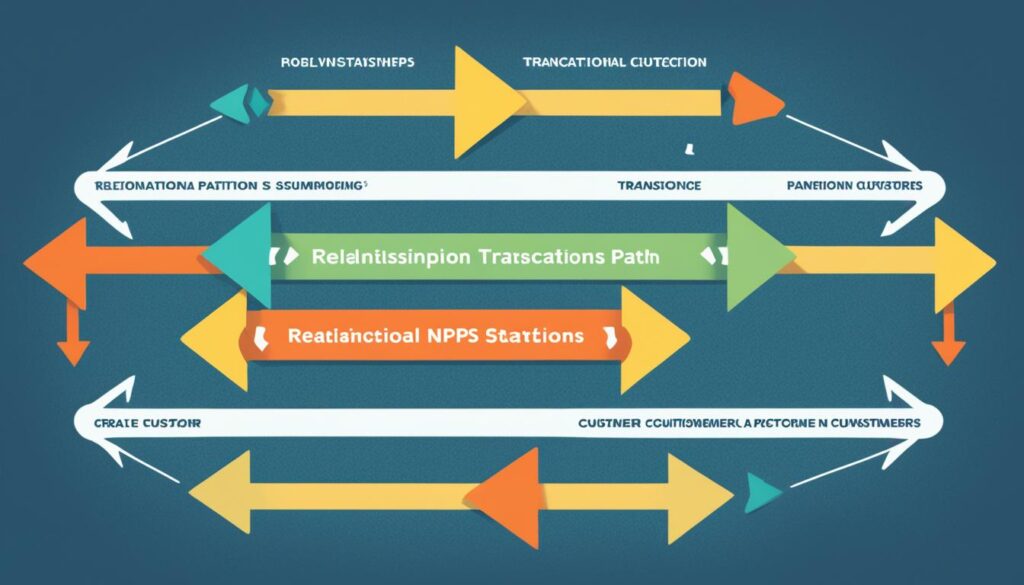Welcome to the world of net promoter score (NPS), a game-changing tool that can elevate your brand’s reputation and drive customer loyalty. NPS is a metric that measures customer satisfaction and their likelihood of recommending your products or services to others. By incorporating NPS into your business strategy, you can gain valuable insights into consumer sentiment, market trends, and brand perception.
Understanding your NPS score is essential for unlocking the potential of your brand. It ranges from -100 to 100 and is calculated based on customer responses to the likelihood of recommending your company. These responses are categorized into promoters (9-10), passives (7-8), and detractors (0-6). By subtracting the percentage of detractors from the percentage of promoters, you will arrive at your NPS score.
But why is NPS so important? It provides actionable insights into customer satisfaction, helps you benchmark your performance against industry standards, and acts as an early warning system for potential customer churn.
Want to know how to calculate your NPS? Stay tuned for the next section where we’ll walk you through the process step-by-step.
What is NPS in Business?
The net promoter score (NPS) is a crucial metric that measures how likely customers are to recommend a company’s products or services. Represented by a number between -100 and 100, NPS provides insights into consumer sentiment and serves as an indicator for customer loyalty and satisfaction.
To calculate the NPS score, customers are asked to rate their likelihood of recommending a product or service on a scale of 0-10. Based on their responses, customers are categorized into three groups:
- Promoters: Customers who rate their likelihood to recommend as 9 or 10.
- Passives: Customers who rate their likelihood to recommend as 7 or 8.
- Detractors: Customers who rate their likelihood to recommend as 0 to 6.
The NPS score is then determined by subtracting the percentage of detractors from the percentage of promoters. The resulting score indicates the overall sentiment towards a company and its offerings.
By utilizing the NPS score calculation, businesses can gain valuable insights into their customers’ likelihood to recommend, helping them prioritize areas for improvement and identify potential issues that may lead to negative feedback.
By incorporating NPS into your business strategy, you can effectively gauge customer satisfaction, enhance brand perception, and cultivate a loyal customer base. Understanding your NPS score is key to driving customer loyalty and optimizing your overall business performance.
How to Calculate Your NPS
To calculate your NPS, you need to send surveys to customers asking them to rate their likelihood of recommending your company on a scale of 0-10. Once you have collected enough responses, you can calculate the percentages of promoters, passives, and detractors. Subtracting the percentage of detractors from the percentage of promoters will give you your NPS score. This calculation can provide valuable insights into customer satisfaction trends and help you identify areas for improvement.
Benefits of Using NPS
Using Net Promoter Score (NPS) can provide several benefits for your business. Incorporating NPS into your strategy offers a simple and effective way to measure customer satisfaction and obtain actionable consumer insights. Unlike complex data analytics, NPS provides a straightforward metric that is easy to calculate and understand.
NPS also serves as a benchmark for customer service, enabling you to compare your performance to industry standards. By measuring and tracking your NPS, you can identify areas of improvement and implement best practices to optimize customer retention, growth, and engagement.
A declining NPS can serve as an early warning sign of customer churn, indicating potential issues or dissatisfaction among your customer base. By regularly collecting NPS data and analyzing it, you can proactively address these concerns, regain customer trust, and enhance their overall experience with your brand.

Key Benefits:
- Simple and easy-to-calculate metric
- Provides actionable consumer insights
- Serves as a benchmark for customer service
- Indicates potential warning signs of customer churn
- Allows for implementation of best practices
- Optimizes customer retention, growth, and engagement
NPS empowers businesses to understand customer sentiment and make informed decisions based on feedback, ultimately enhancing brand reputation and increasing customer loyalty.
What’s a Good Net Promoter Score?
When it comes to evaluating your Net Promoter Score (NPS), determining what is considered a “good” score can be subjective. Several factors come into play, including historical performance, industry benchmarks, and even your competitors’ NPS rankings. However, generally speaking, scores above zero are considered good indications of customer loyalty and satisfaction.
On the other hand, scores above 50 are often seen as excellent and reflect strong customer advocacy and brand loyalty. These high scores suggest that a significant number of customers are likely to recommend your products or services to others, which can translate into increased sales and growth for your business.
However, it’s important to note that scores ranging from 0 to 49 are not necessarily bad. They simply indicate that there is room for improvement in terms of customer satisfaction and loyalty. Such scores warrant attention and efforts to enhance your products, services, or customer experience to increase positive NPS rankings. Remember, even small improvements can have a significant impact on your overall NPS and customer perception.
By regularly monitoring and analyzing your NPS benchmarks and trends, you can gain valuable insights into customer satisfaction levels, identify areas for improvement, and make informed decisions to enhance your brand’s reputation and grow your customer base.

“Your Net Promoter Score can be an essential tool to gauge customer sentiment and loyalty. While higher scores are generally considered better, it’s crucial to remember that any score can be improved. By using NPS as a strategic indicator and continually striving for customer satisfaction, you can propel your business forward.”
Relationship vs. Transactional Net Promoter Scores
When implementing the Net Promoter Score (NPS) in your business, it’s essential to understand the distinction between relationship and transactional NPS. These two categories provide valuable insights into customer loyalty and play a crucial role in identifying areas for improvement in the customer journey.
Relationship NPS: This score is measured over an extended period by periodically surveying established customers to gauge their brand loyalty and sentiment. By collecting feedback from customers who have had ongoing interactions with your company, you can gain valuable insights into their overall satisfaction and likelihood of recommending your brand. Relationship NPS helps you identify areas where you are excelling and where improvements can be made to foster stronger customer loyalty.
Transactional NPS: On the other hand, transactional NPS measures customer sentiment after a specific event in their customer experience journey. This could be an initial purchase, an interaction with customer care, or any other touchpoint that stands out in the customer’s mind. By capturing feedback at these specific moments, you can gain insights into the customer’s immediate satisfaction and their likelihood of recommending your brand based on their recent experience. Transactional NPS allows you to identify potential pain points within specific interactions and take targeted steps to improve customer satisfaction.
Both relationship and transactional NPS provide valuable data for your business. Relationship NPS gives you a holistic view of customer sentiment over time, allowing you to assess the effectiveness of your overall customer experience strategy. Transactional NPS, on the other hand, gives you focused insights into specific touchpoints, enabling you to address immediate concerns and enhance customer satisfaction on a granular level.
Implementing both relationship and transactional NPS in your business can help you create a comprehensive understanding of your customers’ loyalty and satisfaction. By leveraging the insights provided by each type of NPS, you can make informed decisions to improve your customer experience, strengthen brand loyalty, and drive business growth.

Implementing NPS in your business can provide valuable insights into customer sentiment and satisfaction. In the next section, we’ll explore tips for increasing your NPS score and optimizing customer loyalty.
Tips for Increasing Your NPS
Implementing effective NPS best practices is crucial for improving your Net Promoter Score. By prioritizing customer feedback and engagement, you can strengthen customer satisfaction and loyalty. Here are some strategies to help you increase your NPS:
- Include an Open-Ended Question: In your NPS survey, add an open-ended question to gather more detailed feedback from customers. This will provide you with valuable insights into their experiences and areas for improvement. By addressing their specific concerns, you can enhance customer satisfaction.
- Reach Out to Detractors: Identify detractors who have given low NPS scores and reach out to them to understand their concerns. By addressing their issues promptly and effectively, you can turn detractors into promoters. This proactive approach demonstrates your commitment to customer satisfaction.
- Encourage Promoters to Advocate: Engage with your promoters and encourage them to advocate for your brand. Leverage their positive experiences to generate word-of-mouth marketing. Provide incentives for referrals or testimonials to further amplify their advocacy.
- Conduct Competitive Analysis: Perform thorough competitive analysis to differentiate your brand and strengthen your value proposition. Understand what your competitors are doing well and identify gaps that you can fill. By offering unique features or superior customer service, you can attract more customers and improve your NPS.
By continuously monitoring your NPS score, implementing these best practices, and incorporating customer feedback into your decision-making, you can enhance customer satisfaction, build a loyal customer base, and drive business growth.

Leveraging NPS for Improved Customer Loyalty
Integrating NPS into your customer service research is a powerful way to unlock valuable insights that can drive customer loyalty and deliver exceptional product experiences. NPS surveys provide a quantifiable measure of customer loyalty, serving as a foundation for actionable improvements.
One effective strategy is to analyze the verbatim comments from both promoters and detractors. These comments can offer invaluable feedback and help you pinpoint specific areas for product and customer experience enhancements. By understanding the drivers behind promoter loyalty and addressing the concerns of detractors, you can cultivate a loyal customer base and enhance your overall brand perception.
NPS analysis allows you to delve deeper into the sentiments and preferences of your customers, enabling you to make informed decisions to optimize your products or services. By actively seeking NPS feedback, you demonstrate a commitment to serving your customers better and continuously improving their experiences.
FAQ
What is NPS in Business?
NPS, or Net Promoter Score, is a powerful tool for quantifying customer satisfaction and word-of-mouth marketing. It measures the likelihood that customers will recommend a company’s products or services to others, providing insights into market trends, consumer satisfaction, and brand perception. Using NPS can effectively boost your brand’s reputation and grow your customer base.
How to Calculate Your NPS?
To calculate your NPS, you need to send surveys to customers asking them to rate their likelihood of recommending your company on a scale of 0-10. Once you have collected enough responses, calculate the percentages of promoters, passives, and detractors. Subtracting the percentage of detractors from the percentage of promoters will give you your NPS score, which provides valuable insights into customer satisfaction trends and areas for improvement.
What are the Benefits of Using NPS?
Using NPS offers several benefits for your business. It is a simple metric to calculate and provides actionable consumer insights without the need for complex data analytics. NPS also serves as a benchmark for customer service, allowing you to compare your performance to industry standards. Additionally, a declining NPS can indicate warning signs of customer churn, helping you address issues and regain customer trust.
What’s a Good Net Promoter Score?
The determination of a good NPS score depends on various factors such as historical performance, industry benchmarks, and competitors’ NPS. Generally, scores above zero are considered good, while scores above 50 are deemed excellent. However, scores between 0-49 are not necessarily bad, as long as efforts are made to improve and increase positive NPS rankings.
What is the Difference Between Relationship and Transactional NPS?
NPS can be categorized into relationship and transactional scores. Relationship NPS is measured over a long duration by periodically surveying established customers to monitor brand loyalty and sentiment. Transactional NPS, on the other hand, measures customer sentiment after a specific event in the customer experience, such as a first purchase or interaction with customer care. Both types of NPS provide insights into customer loyalty and can help identify areas of improvement in the customer journey.
What are Some Tips for Increasing Your NPS?
There are several strategies you can implement to increase your NPS score. These include including an open-ended question in your NPS survey to gather more detailed feedback, reaching out to detractors to understand and address their concerns, encouraging promoters to continue advocating for your brand, and conducting competitive analysis to differentiate your brand and strengthen your value proposition. By continuously monitoring and improving your NPS score, you can enhance customer satisfaction and loyalty.
How Can NPS Improve Customer Loyalty?
By incorporating NPS into your customer service research, you can unlock valuable insights that drive customer loyalty and deliver exceptional product experiences. NPS surveys provide a measure of customer loyalty and serve as a basis for actionable improvements. Analyzing verbatim comments from promoters and detractors can help identify areas for product and customer experience enhancements. By understanding the drivers behind promoter loyalty and addressing detractors’ concerns, you can cultivate a loyal customer base and improve your overall brand perception.
